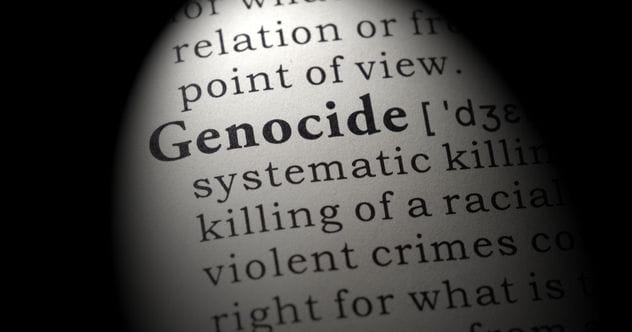Genocide stands as one of humanity’s most horrifying acts. It’s the deliberate and systematic destruction of an ethnic, racial, or religious group, aiming to erase them entirely. The sheer scale of human suffering caused by genocide is almost beyond comprehension, often involving mass killings, torture, and unimaginable brutality.
These horrific events are frequently fueled by deep-seated prejudice and an intense desire to eliminate a targeted group. Motivations can range from greed for land and resources to a twisted sense of power or revenge for past wrongs, real or imagined. Regardless of the cause, the consequences for survivors are devastating, leaving scars of pain and trauma that echo for generations.
The Holocaust, where Nazis systematically murdered six million Jews during World War II, is perhaps the most infamous example. Yet, it’s tragically not alone. The 1994 Rwandan genocide saw around 800,000 Tutsis and moderate Hutus slaughtered. More recently, the persecution of the Rohingya people in Myanmar highlights the ongoing horror genocide brings. While these atrocities are widely acknowledged, many others have faded into the background. This list sheds light on ten such genocides that history class might have missed.
The Solomon Islands’ Tensions: Up To 1,000 Dead
A dark chapter in the Solomon Islands’ history, “The Tensions” refers to a period of civil unrest and ethnic conflict. Starting in 1998, militant groups from Guadalcanal province began attacking migrants from the nearby Malaita province. The Guadalcanal natives accused the Malaitans of taking jobs and land. This violence quickly escalated, lasting for several years.
The conflict led to tens of thousands being displaced and hundreds, possibly up to a thousand, Malaitans killed. Around 40,000 others fled on small boats to Bougainville in Papua New Guinea. The Regional Assistance Mission to the Solomon Islands (RAMSI) intervened in 2003, eventually resolving the conflict. However, the emotional wounds remain.
During this period, both sides committed terrible acts, including murder, rape, and torture. Guadalcanal militants targeted Malaitan migrants, while Malaitan militants retaliated with their own violence. Underlying ethnic tensions, worsened by migration, fueled the conflict.
The impact was profound, tearing families apart and destroying communities. Unfortunately, the troubles may not be over. Fresh attacks targeting Chinese immigrants in Honiara, the capital, occurred in 2020 and 2021. Observers worry that while not yet at the level of The Tensions, the situation could worsen.
Herero and Nama Genocide: 80,000 Deaths
The Herero and Nama genocide was a tragic event in German South West Africa (now Namibia) in 1904. The German colonial power made a concerted effort to eliminate the Herero and Nama peoples and seize their land. Disputes over land and resources sparked the conflict, as German settlers aimed to expand their territory.
The genocide began with the Battle of Waterberg, where the Herero were vastly outnumbered. German forces used brutal tactics, including poisoning water sources and herding people into concentration camps. Many Herero died from forced labor, medical experiments, or exhaustion in these camps. This genocide resulted in the deaths of up to 80% of the Herero population, estimated at around 80,000 people.
The aftermath was equally devastating. The Herero people lost their land and their traditional way of life. German control over the region continued and even expanded. The trauma and loss have been felt for generations and remain a contentious issue today.
Recently, the German government acknowledged its role in the genocide. They have offered a formal apology and started funding development projects in Namibia. The 1904 Herero genocide is a stark reminder of colonialism’s devastating impact and the ongoing fight for justice in post-colonial societies.
Kurdish Genocide: 185,000 Deaths
The Anfal campaign, also known as the Kurdish genocide, involved brutal attacks in Iraq’s Kurdistan region from 1986 to 1989. Ordered by Saddam Hussein’s Iraqi government, it aimed to suppress the Kurdish population’s movement for autonomy.
The campaign began with a chemical weapons attack that killed hundreds of Kurds, marking the first time a nation used such weapons against its own citizens. Over the following months, the Iraqi government continued its horrific violence against the Kurdish people, including bombings, executions, and mass killings.
The Anfal campaign led to the deaths of tens of thousands of Kurds, with estimates ranging from 50,000 to nearly 185,000. Many Kurdish villages were destroyed, and their inhabitants were rounded up, detained, and executed without trial. The international community widely condemned the campaign over the years, imposing strict sanctions on Iraq.
The Anfal campaign is still considered one of the most brutal acts of violence against the Kurdish people. It has left a lasting impact on the Kurdish community, which continues to seek greater autonomy and recognition of its cultural identity. They come together annually to remember the atrocities of Iraq’s Anfal campaign.
Mayan Genocide: 200,000 Deaths
Guatemala’s persecution of the Mayan people in the late 20th century is often called the Mayan Genocide. The government’s campaign to eradicate the Maya was brutal. The army used various tactics to destroy small, indigenous Mayan communities, with particular intensity during the 1980s.
In that decade, the government launched Operation Sophia, a secret plan to wipe out the country’s entire Mayan population. This plan involved killing 200,000 native people and displacing another 1.5 million. Many of those displaced fled to Mexico, living in dangerous refugee camps for years.
Guatemala’s violent tactics were heinous. Villages were razed, livestock slaughtered, water supplies poisoned, and sacred sites desecrated. The Guatemalan military used rape, torture, and other forms of violence to terrorize the Mayans. Many people were forcibly kidnapped and disappeared, their bodies never recovered. The conflict ended in 1996 after international intervention helped secure peace.
However, the genocide’s effects are still felt in Guatemala today, especially among surviving Mayan communities. Efforts to bring those responsible to justice have been slow, though some recent progress has been made in prosecuting those involved. Mayan activists continue to demand more action.
East Timor Genocide: 200,000 Deaths
East Timor, a small island nation in Southeast Asia, was a Portuguese colony until Indonesia invaded in 1975. The Indonesian occupation lasted nearly 25 years and was marked by widespread violence and genocide. During this time, up to 200,000 people died, roughly one-quarter of East Timor’s entire population.
Indonesian forces used starvation as a weapon, even poisoning food and water with napalm and hazardous chemicals. Death squads executed thousands, often with savage cruelty, to instill terror among pro-independence supporters.
In 1999, after 78% of the population voted for independence, Indonesia withdrew. The United Nations then helped rebuild the country. However, justice for the atrocities has been slow. Indonesian generals have never been fully prosecuted for these crimes against humanity.
Since independence, armed groups have continued to cause violence, destroying villages and murdering at least another 1,500 people. Despite these challenges, East Timor has made progress, becoming a UN member in 2002 and resolving a maritime border dispute with Australia in 2018. Though moving towards stability, the genocide by Indonesia remains one of the most vicious and yet lesser-known of the late 20th century.
Bangladesh Genocide: 3 Million Deaths
In 1971, Dhaka was the capital of East Pakistan, ruled by West Pakistan from across the Indian subcontinent. The Bengali population in East Pakistan, a majority in the colony, resented political and economic exploitation by their western counterparts and sought independence.
When West Pakistan ignored the election of Sheikh Mujibur Rahman, leader of the separatist Awami League party, as East Pakistan’s prime minister, tensions erupted. Widespread military violence involving Bengalis, Pakistanis, and Indians occurred in East Pakistan from March to December 1971, with at least 300,000 war deaths.
However, the full scale of the genocide against civilians only became clear later. In late 1971, Archer Blood, the American Consul General to Dhaka, accused West Pakistani soldiers of “systematically eliminating” the Bengali independence movement, slaughtering patriots by the thousands. U.S. President Richard Nixon, considering West Pakistan a key Cold War ally, ignored Blood’s claims.
But the atrocities were too massive to hide. Mass rape was used to terrorize Bengali women, while men were massacred. The creation of a generation of “war babies” with West Pakistani heritage came to light years later. Ultimately, more than 3 million Bengali people died in the year-long conflict.
The genocide ended on December 16, 1971, when Pakistani troops surrendered to invading Indian forces. The conflict profoundly impacted the Bengali population, leading to the birth of their own nation, Bangladesh, and shaping South Asian history for decades.
Greek Genocide: 1.5 Million Deaths
Many are aware of the horrific Armenian Genocide in the early 20th century, where Ottoman rulers killed over a million Armenians. Sadly, this wasn’t the only atrocity committed by the Ottomans. Greek communities in Thrace were also targeted in the 1910s, resulting in the deaths of nearly 1.5 million Greeks.
Christians, including Armenians and Greeks, were primary targets of the Ottoman Empire’s wrath. They suffered unspeakable atrocities: rape, mass murder, death marches, deportations, and torture. The Ottoman Empire also kidnapped many Greeks, forcing them to convert to Islam or labor in work camps, while relentlessly destroying Christian monuments and culture.
The horrors continued into the early 1920s. Many Greek communities across the Ottoman Empire were affected. In İzmit, about 60 miles from Istanbul, 12,000 people were murdered, and around 30 Greek villages were burned in early 1922. A particularly heinous act was the burning of Smyrna, which concluded the Greco-Turkish war, killed thousands, and left the city in ruins.
The genocide ended with the Treaty of Lausanne, which included a mandatory population exchange between Greece and Turkey. The treaty’s legacy is controversial, seen by some historians as a precedent for forcibly relocating populations. Nevertheless, it stopped the slaughter of Greeks in what is now Turkey.
Circassian Genocide: 1.5 Million Deaths
Sir Francis Palgrave, a respected British diplomat, witnessed the Circassian genocide in the early 19th century. He wrote, “Their only crime was not being Russian,” a haunting observation. This was the first genocide of the 19th century. Carried out by Russian forces, it eliminated over 90% of the Circassian people, making it one of history’s most effective genocides.
The Circassians had lived in the North Caucasus region for thousands of years. During the Russo-Circassian war, the Russian Empire sought to push its border south into the Caucasus mountains for greater access to the Black Sea. To achieve this, Russian forces used genocidal tactics: spoiling food, destroying homes, mass deportations, kidnappings, and summary executions.
Historians believe over 1.5 million Circassians were slaughtered as Russian forces moved south. Sadly, many people worldwide are unaware of this genocide. The Circassian diaspora is now found in Turkey, Russia, and globally.
Descendants continue to remember. The “No Sochi” campaign opposed the 2014 Sochi Olympic Games because the Circassians, indigenous to the region, were not part of the Olympics. While the protest didn’t stop the games, it brought attention to this lesser-known tragedy.
Cambodian Genocide: 2 Million Deaths
In the early 1970s, Cambodia was torn by civil war. The Khmer Rouge, led by Pol Pot, made gains across the countryside, planning to attack the capital, Phnom Penh. They succeeded in 1975, declaring “Year Zero” and beginning their radical communist agenda. The Khmer Rouge aimed to create an agrarian utopia by destroying all existing culture.
They forced citizens into hard labor with minimal training. Anyone resisting or suspected of resisting faced torture and death. Intellectuals were among the first to die; merely wearing glasses could mark someone for execution. Over several years, the brutal regime’s grip on Cambodia resulted in the deaths of up to two million people, over one-fifth of the population at the time.
The Khmer Rouge’s reign of terror ended in 1979 when Vietnam invaded Cambodia with little resistance. However, Pol Pot never faced justice for his crimes, dying in exile in 1998. The atrocities committed during their four-year rule still haunt Cambodia. Survivors and their descendants continue to seek justice and healing.
Since the genocide, efforts have been made to preserve Cambodia’s cultural heritage and ensure such horrors are never repeated. The Khmer Rouge’s legacy is a sobering reminder of unchecked power and the importance of protecting human rights.
Holodomor: 5 Million Deaths
Between 1932 and 1933, the Soviet Union implemented a brutal collectivization of agriculture in Ukraine. The Soviets imposed a communist farming policy, confiscating food and prohibiting private property. This led to a catastrophic crop failure, reducing farm output, disrupting supply chains, and causing dire food shortages. This man-made famine, known as the Holodomor, claimed approximately 3.9 million Ukrainian lives, with an additional 1 million deaths in other parts of the USSR.
Gareth Jones, a Welsh journalist, exposed the famine’s horrors. He reported firsthand accounts of people in utter desperation, forced to eat bark, grass, hay, and even human flesh. Western journalists, including Pulitzer Prize winner Walter Duranty, were skeptical, choosing to believe Soviet propaganda portraying collectivization as a success. Duranty dismissed famine reports as “malicious propaganda.”
The Holodomor was denied not only by Stalin’s regime but also by many Western journalists favored by the Soviets. Over time, the true extent of the forced famine became known. Tragically, Gareth Jones was murdered years later during an assignment in Mongolia; many believe the Soviets were responsible.
The Holodomor remains a painful chapter in Ukrainian history. Its impact on generations is still felt. This unnecessary famine could have been avoided if not for the Soviet government’s brutal policies. Gareth Jones’s bravery in exposing the truth highlights the importance of free, independent journalism. His legacy reminds us of the atrocities committed when truth is suppressed.
Remembering these horrific events, no matter how painful, is crucial. It honors the victims and serves as a stark warning against the ideologies and hatreds that fuel such atrocities. We must learn from these dark chapters to ensure they are never repeated.
What are your thoughts on these forgotten genocides? Leave your comment below and share this article to help keep their memory alive.










